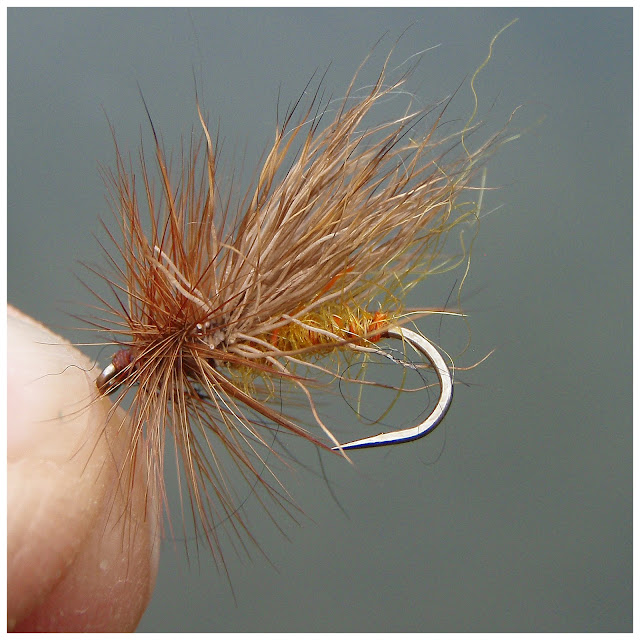Use a strong tippet in the larger sizes. Be ready for sudden, violent rises when there is not much going on.
Use it when you expect to get a bit of drag. Twitch it on slow or still pools. It continues working even after the trout have trimmed its wing into a little stump of deer hair, so don't throw them away.
Last night I was told that you should tie six of these rather than five as folk will want more than one from you!
The hook sizes can vary from size 8 down to 14 depending on the sedge flies that are about. In the colour scheme here it seems to represent the Great Red Sedge quite well but it is not an exact match for anything. It hints at everything instead. Use pale materials and it makes a good moth for those all nighters in high summer when the scent of sweet rocket fills your nostrils and the air feels heavy with the prospects of good Sport...
Dub on a fairly generous pinch of cinnamon seal's fur - it's a mucky yellowy olive colour
|
 |
Wind the body, the seal's fur should be used up just as you reach the end of the body
|
 |
Rib the body with open spiralled turns of the thread and then continue for four turns to make a bed for the wing
|
 |
Take a bunch of deer hair and gauge it against the body and bend so the tips are roughly aligned with the hook bend
|
 |
Swap hands and hold the bunch of deer hair tight, clip off the waste prior to tying the bunch in
|
 |
Tighten up the turns and make the wing flare a little as you tie it tight next to the body
|
 |
Trim off the flared waste ends and dab a small spot of varnish on the remaining root ends of the deer hair. (I use Sally Hanson Hard as Nails.)
|
 |
Before the varnish has dried wind the thread forward to make a bed for the hackle stalk
|






Nice looking flies looking forward to seeing more...
ReplyDeletewww.bigerrfish.blogspot.com
Hi there, I've been following your blog for a while now, and have used it as a guide with some success. I'm also relatively new to fly tying and would really appreciate a little guidance as to which hook you've used here and where to acquire cinnamon seals fur? I’ll understand if you don’t feel like giving away all your trade secrets though! Many thanks, keep up the good work. Patrick
ReplyDeleteHello Patrick
ReplyDeleteYou put me on the spot there! The hooks I use are ones I acquired over the years and they are not all still available.
These are old hooks that you might be able to find:
VMC: 9285
Mustad: 7780C,9143, 39846
Albert Partridge: Type A Wide Gape Fly Hook
These are still available:
Sprite: Carp, Perfect Medium, Trout Down Eyed
Ashima: F-30
You will need to bend your own offset or reverse into these hooks with pliers after you have debarbed them.
Cinnamon seal's fur is not the colour of cinnamon but the colour of the abdomen of the cinnamon sedge (so called because it allegedly smells and tastes of cinnamon). The true colour is as per the photographs, a yellowy pale gingery gold(ish) colour. You can use other colours such as: natural, amber, ginger, light olive and so on. The anatomy of the fly is designed to hint at lots of different sedge flies, the colours in the pictures above are the ones that seem to be very versatile and work very well.
I got my hooks and the seal's fur from Tom C Saville http://www.tomcsaville.com which is now incorporated with Walkers of Trowell not far from J26 on the M1. From Derby you mght use the A52 and turn left up Ilkeston Road to Trowell it is immediately on your left if you turn right on the A609. If you have not visited this establishment yet you should do so as soon as possible, it would make a good local tackle shop for you.
Regular Rod
Thanks for the swift reply. I'll certainly have a look into that tackle shop - I hadn't even heard of it let alone visited it. Fortunately, I have plenty of deer hair to experiment with so I'm looking forward to having a crack at this. I'll no doubt be picking your brains again soon! Cheers, Patrick
ReplyDeleteExcuse me for asking RR, but what is the make of that cane rod in the top photo with the trout?
ReplyDeleteHi JB
DeleteIt's a Gary Marshall creation from www.finecanerods.com whom I rate as one of the very best cane rod builders anywhere. Gary listens to you, watches you cast, asks questions about how you fish and then builds the perfect rod to suit you.
That example is 8ft 6in for a #5 line and weighs only 4 1/4 oz. being hollow built!
Regular Rod